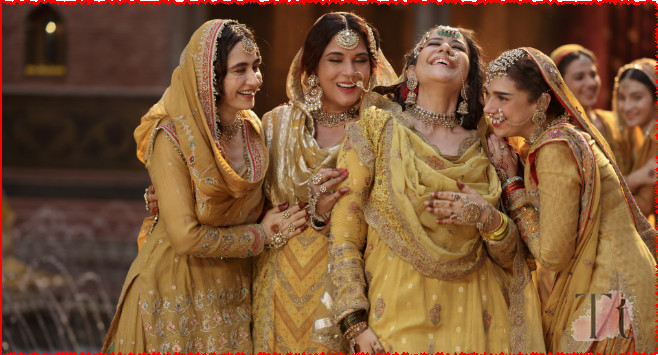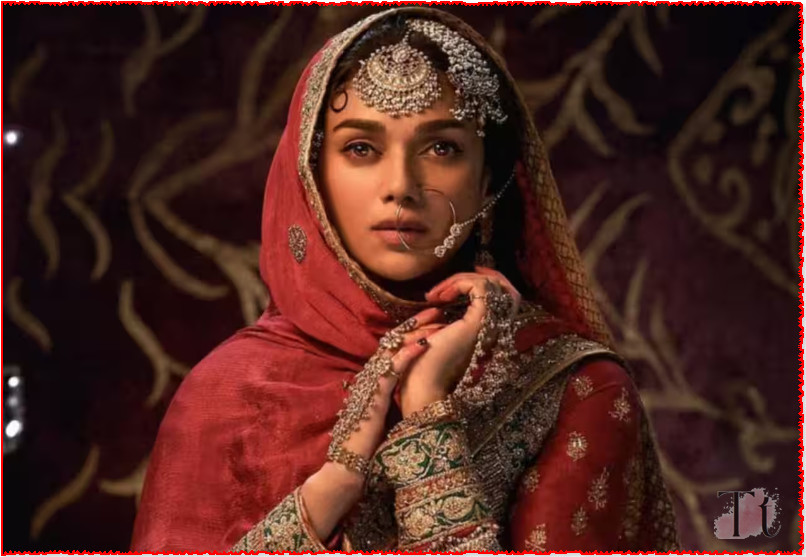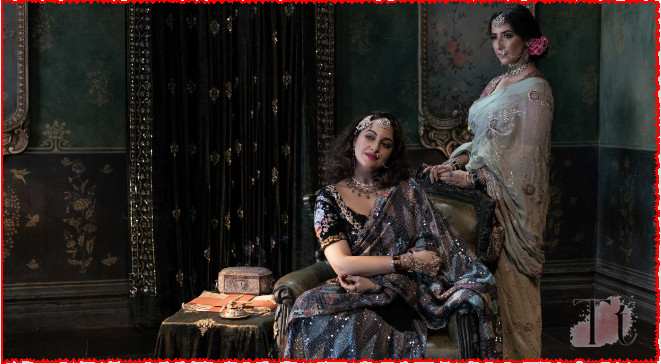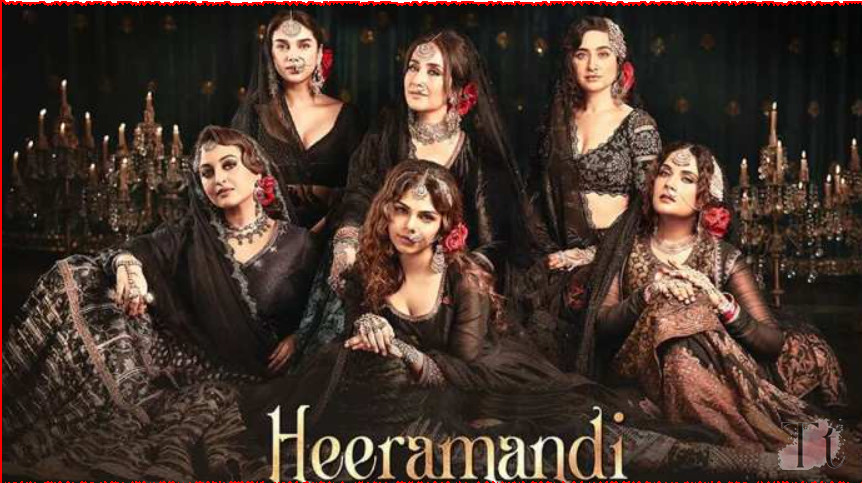“Heeramandi” symbolizes a significant shift for Sanjay Leela Bhansali, as he ventures into the realm of streaming platforms, a transition that doesn’t diminish his artistic grandeur. This series serves as a reunion between Bhansali and Manisha Koirala, who have previously collaborated on memorable cinematic ventures like “1942: A Love Story” and “Khamoshi: The Musical.”

Table of Contents
The narrative unfolds in the vibrant backdrop of pre-Independence India, specifically within the bustling diamond bazaar of Heeramandi in Lahore. At the heart of the story is Mallika Jaan, portrayed by Koirala, the indomitable madam of a brothel. Koirala’s portrayal brings a depth to Mallika Jaan, depicting a character steeped in past glories yet restrained by them, a complexity skillfully conveyed through her nuanced expressions and gestures.
What distinguishes “Heeramandi” is Bhansali’s newfound freedom in the long-format storytelling of a series. Unlike his cinematic endeavors, the series doesn’t rely on star power or extravagant spectacle to captivate audiences. There are no iconic moments reminiscent of Aishwarya Rai’s flamboyant sari in “Devdas” or Madhuri Dixit’s enchanting mujra performances. Instead, the narrative prioritizes storytelling and character development, maintaining a pace that eschews indulgent slow-motion shots.
Despite its setting within a world of courtesans and nawabs, “Heeramandi” defies expectations by presenting mujra performances as acts of self-expression rather than mere entertainment for men. Each dance becomes a poignant statement of agency, underscoring that the tawaifs dance for themselves, reclaiming their autonomy and dignity.
In essence, “Heeramandi” represents a departure from Bhansali’s familiar cinematic style while retaining his hallmark themes of love, rebellion, and freedom. It serves as a testament to his evolution as a filmmaker and marks a promising debut in the realm of streaming content, hinting at a new chapter in his illustrious career.
Unveiling the Mastery: Sanjay Leela Bhansali’s ‘Heeramandi’ and its Unified Narrative Brilliance
“Heeramandi” stands as a testament to Sanjay Leela Bhansali’s mastery, showcasing a rare synergy where its myriad elements merge seamlessly into a unified narrative tapestry. Unlike many productions where standout moments feel disconnected from the overarching story, each aspect of “Heeramandi” contributes substantively to its overarching themes and character arcs.

A prime example of this integration is seen in the song “Azadi,” where the tawaifs defiantly march towards a prison wall, bathed in the glow of torchlight, confronting police obstruction. While this scene may lack the visual spectacle of Bhansali’s previous works like the jauhar sequence in “Padmaavat,” its impact resonates deeply due to the meticulous investment in character development woven throughout the series.
Bhansali’s narrative approach in “Heeramandi” is characterized by a lean yet potent style, where every scene serves a distinct purpose without any narrative filler. Each moment resonates with viewers, leaving an indelible mark through memorable dialogues, visually striking frames, or moments worthy of applause. Amidst the backdrop of India’s freedom struggle, Bhansali deftly navigates the intricate web of relationships among the tawaifs, whether exploring the nuances of mother-daughter dynamics, sibling rivalries, or other interpersonal conflicts. This interplay of personal drama against the broader canvas of historical events lends depth and complexity to the storytelling, enriching the audience’s engagement with the narrative.
The portrayal of kotha politics within “Heeramandi” serves a dual function, infusing the drama with intrigue and tension reminiscent of saas-bahu operas, while also elevating it to the level of a prestige drama through its nuanced execution. Bhansali draws compelling parallels between the power struggles within the brothel and the larger dynamics of India’s fight for independence, underscoring how internal divisions can hinder collective action and societal progress.
Furthermore, Bhansali’s exploration of the individual struggles faced by the tawaifs underscores the interconnectedness of personal and national liberation. By highlighting the parallels between the fight for self-expression within the confines of the brothel and the broader struggle for political freedom, Bhansali emphasizes the importance of individual agency in driving societal change. The tawaifs’ resignation to their fate serves as a poignant reflection of the societal complacency towards colonial oppression, with entrenched hierarchies and power dynamics stifling collective resistance.
However, it is the emergence of solidarity and collective action among the tawaifs that catalyzes a transformative rebellion, challenging the status quo and paving the way for revolution. In this way, “Heeramandi” transcends its historical setting to offer a timeless exploration of the human spirit and the enduring quest for freedom and empowerment.
Heeramandi: A Masterclass in Ensemble Acting
In “Heeramandi,” the ensemble cast delivers performances that are both captivating and multi-layered, enriching the narrative tapestry woven by Sanjay Leela Bhansali. At the forefront is Manisha Koirala’s portrayal of Mallika Jaan, which stands out as a masterclass in acting. With her commanding presence and nuanced expressions, Koirala brings Mallika Jaan to life, making her a complex and compelling character. She effortlessly balances the character’s intimidating exterior with the vulnerability hidden beneath, eliciting both fear and empathy from the audience.

Aditi Rao Hydari, known for her expressive eyes, delivers another standout performance in “Heeramandi.” She infuses her character with depth and complexity, portraying a woman with a latent edge and a simmering heart. It’s a refreshing departure from her previous roles and showcases her versatility as an actress. However, while Richa Chadha delivers a solid performance, her role in “Heeramandi” lacks the impact of her previous standout scenes, such as in “Goliyon Ki Rasleela: Ram-Leela.”
Sonakshi Sinha impresses once again with her emotional depth and versatility, providing a compelling portrayal of a character grappling with inner turmoil. Sanjeeda Sheikh delivers a powerful performance, capturing the essence of a woman consumed by greed and vengeance. Her portrayal is raw and authentic, showcasing her talent and range as an actress.
Sharmin Segal and Taha Shah Badussha inject youthful energy into the narrative with their performances as hopeful lovers in troubled times. While Sharmin’s performance occasionally draws comparisons to other actresses, she shows promise and potential for growth. Taha delivers a consistently vulnerable and resolute performance, establishing himself as a talent to watch out for.
The supporting cast, including Fardeen Khan, Shekhar Suman, and Adhyayan Suman, deliver competent performances that complement the central narrative. Farida Jalal shines in her role as a dadi, infusing her character with warmth and vitality.
Anju Mahendru’s cameo as Fufi adds depth to the narrative, serving as a reflection of the audience’s voyeuristic gaze. Her character’s evolution from endorsing competition among tawaifs to mobilizing them against the British highlights the transformative journey of the narrative.
In conclusion, the ensemble cast of “Heeramandi” delivers stellar performances that enhance the storytelling and deepen the audience’s engagement with the narrative. Each actor brings depth, nuance, and authenticity to their respective roles, contributing to the rich tapestry of characters that populate Bhansali’s provocative frontier of streaming content.

Exploring the Magnificence and Depth of “Heeramandi”: Sanjay Leela Bhansali’s Cinematic Triumph
Sanjay Leela Bhansali’s “Heeramandi” is a testament to the filmmaker’s dedication and vision, with a production journey spanning 14 years. This web series, comprising eight episodes ranging from an hour to 50 minutes each, offers a sprawling narrative set in the 1920s, centered around the enigmatic world of Heeramandi and its inhabitants, particularly Mallika Jaan, portrayed by the remarkable Manisha Koirala. Bhansali’s creative license allows him to delve deep into this world of nautch girls and their intricate social dynamics.
The series is a quintessential Bhansali venture, characterized by opulent sets, visual splendor, intense emotions, and compelling performances. Set against the backdrop of 1940s Lahore, “Heeramandi: The Diamond Bazaar” paints a vivid portrait of the city’s red-light district, prioritizing the overall impact of the narrative over historical accuracy. While it boasts moments of effulgent beauty, it occasionally veers into tonally static stretches, but its strengths overshadow its flaws.
Bhansali serves as the creator, co-writer, editor, and music director, ensuring that every aspect of the production reflects his grand cinematic vision. Inspired by an original concept by Moin Beg, the series juxtaposes the struggles of courtesans with the backdrop of India’s fight for independence, led by underground rebels.
The ensemble cast, including Sonakshi Sinha, Aditi Rao Hydari, Richa Chadha, Sanjeeda Sheikh, and Sharmin Segal, delivers standout performances that breathe life into their characters. Koirala’s portrayal of Mallika Jaan is particularly noteworthy, showcasing her depth and versatility as an actress.

While the male cast, including Fardeen Khan and Shekhar Suman, play peripheral roles, Taha Shah, Jason Shah, and Indresh Malik leave a lasting impression with their performances. Through their characters, Bhansali explores themes of desire, betrayal, and the transient nature of power and wealth.
The series delves into the intricacies of power dynamics and societal norms, portraying the courtesans as both victims and agents of their fate. Despite their closely-knit community, characterized by blood relations, they are not immune to jealousy and betrayal, reflecting the complexities of human relationships.
“Heeramandi: The Diamond Bazaar” sustains its focus on the women of Heeramandi while weaving a tapestry of love, jealousy, deceit, and rebellion against the backdrop of a changing society. As the rumblings of the swadeshi movement reverberate through Heeramandi, the courtesans find themselves at a crossroads, torn between loyalty to the nawabs and allegiance to the freedom fighters.
Beyond its visual splendor, the series offers a poignant commentary on India’s fight for independence, emphasizing unity across religious divides. In today’s polarized climate, Bhansali’s portrayal of communal harmony serves as a powerful thematic undercurrent, highlighting the enduring spirit of syncretism in the subcontinent’s cultural landscape.
In conclusion, “Heeramandi” is more than just a sumptuous visual spectacle; it is a thought-provoking exploration of history, identity, and resilience. Bhansali’s magnum opus transports viewers to a bygone era while offering insights that resonate deeply with contemporary sensibilities.
